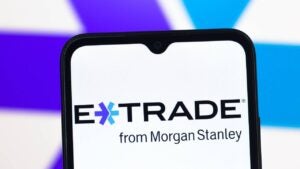Schwab Slices vs. Fidelity Stocks by the Slice: Which is better?

Investing in fractional shares is a cool feature, especially for beginning investors. If you use a broker that lets you buy partial shares, you can put all your cash to work instead of saving up to buy only whole shares of stock or ETFs. And that’s particularly beneficial if you’re investing modest sums regularly or getting started on your investing journey when you have less money.
Two of the best brokers overall – Fidelity Investments and Charles Schwab – are also among the best for those investing in fractional shares. But which is better for partial shares?
Charles Schwab vs. Fidelity Investments: Fractional investing
Charles Schwab’s fractional share program is called Stock Slices, while Fidelity’s is Stocks by the Slice. Creative names, but it’s a dead heat so far. Here’s how they stack up on what matters.
Purchases and dividend reinvestment
The best brokers for fractional shares offer both the ability to purchase partial shares of stock and ETFs and the ability to reinvest your dividends as fractional shares. Some brokers offer one or the other, but the best offer both – as do Schwab and Fidelity. So when you get your dividends, you can instruct either to reinvest that money into more shares, even partial shares.
As is typical across brokers offering partial shares, when a company pays a dividend, you’ll receive your equivalent portion of the payout for any fractional amounts in your account. If you own a half share of stock, you’ll get a half share’s worth of the dividend and, of course, the full dividend for any whole shares of the stock that you own, too.
Edge: Even
Available securities
The number of available securities in each broker’s program differs markedly, and it’s one of the key differentiators between the two programs.
Fidelity has more than 7,000 securities available in its fractional share plan, including not only stocks but also exchange-traded funds (ETFs). So if you want that high-priced S&P 500 ETF but don’t have enough coin for a full share, then you can buy a partial share at Fidelity. It’s an utterly massive range of securities and likely encompasses what almost all investors will want to own.
In contrast, Schwab offers its program for only the 500 or so stocks in the S&P 500. These are the market’s most highly traded stocks and comprise the vast majority of the total dollar volume on the exchanges, so this selection may suffice for many investors looking for large-cap stocks.
Edge: Fidelity
Trade interface
Each broker has a surprisingly different trade interface, but Schwab’s is much easier for entering multiple orders.
With Schwab, you can’t enter an order for partial shares on the usual trade ticket or order entry page. Instead, you need to go to a special “Schwab Stock Slices” tab to place your order. Once there, you can search for the S&P 500 stock you want or click it from a list. You can enter all the stocks you want at one time, and you’re able to choose up to 30 stocks at once to buy.
Click continue, and on the next screen you can enter your total investment amount. Schwab divides this amount evenly among the total number of stocks you want to buy. Review the trade and then place the order, and you’ll soon own partial shares of the selected stocks.
At Fidelity to place an order for partial shares you use the regular trade interface. However, instead of entering the number of shares you want to buy, you click a tab for the amount of dollars that you want to invest. For an individual trade, it’s plenty easy to enter and execute.
If you’re looking to purchase multiple stocks at one time, albeit only those on the S&P 500, Schwab’s interface lets you enter them quickly, and up to 30 stocks at once. The downside here is that if you want to invest different amounts in each stock, you’ll need to enter separate orders.
If only one of these top two brokers – or Interactive Brokers, another top place for partial shares – would combine the best of both worlds: a trade interface with multiple securities, virtually all the market’s stocks and the ability to invest different amounts as part of the multi-trade order.
Edge: Schwab
Minimum trade
The brokers differ on their minimum trade size for partial shares but the difference ends up being modest. Fidelity requires just a $1 minimum for partial shares, while Schwab requires a still affordable $5 per partial share order. Not a heavy lift with either brokers.
As far as maximum trade amount goes, Fidelity has none for partial shares, while Schwab caps its orders at $50,000 per trade. So if you’re placing a trade above that amount, you’ll need to split it into two or more orders – hardly a dealbreaker when trade commissions are zero.
Edge: Effectively even
Order types
When investors place a stock trade, they can choose between a market order or a limit order. With a market order, the trade will be executed at whatever the prevailing price is at the moment. In contrast, a limit order lets you specify what price you want for your trade, and then the broker executes the order only when you can obtain that price or better.
Fidelity lets you enter market and limit orders, allowing you to choose whether you want your trade to execute now or when it hits a certain price. The nice part about limit orders is that you don’t have to keep following the market waiting for your price, as you would with a market order. You can place your limit order and Fidelity will execute the trade if and when it hits your price.
In contrast, Schwab offers only market orders when trading partial shares. While that’s less attractive, it makes less of a difference on the large and liquid stocks that populate the S&P 500, which Schwab’s plan is limited to. So unless you’re trading big, it’s not likely to matter much on the price you get. Where it will matter is if you’re looking for a specific price on a stock, since you’ll need to keep checking the market to see if it’s time to enter your order.
Edge: Fidelity
Bottom line
Fidelity’s program for partial shares is an attractive feature, and it’s one reason that Bankrate names Fidelity the top broker for beginning investors for 2023. Of course, Bankrate named Charles Schwab its top broker overall for 2023 – so you’re not going to go wrong either way.
Why we ask for feedback Your feedback helps us improve our content and services. It takes less than a minute to complete.
Your responses are anonymous and will only be used for improving our website.
You may also like

Fidelity Investments vs. Vanguard





